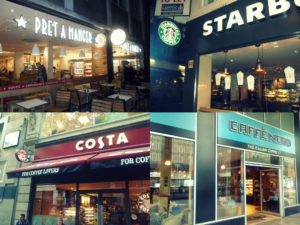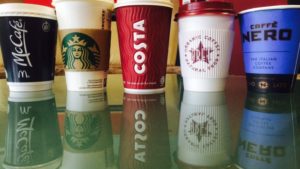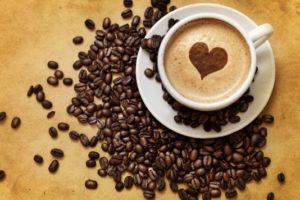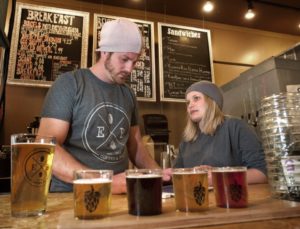 Coffee shops, it seems no UK high-street is complete without one, and proving consumers passion for espressos, lattes and cappuccinos, new research from Mintel reveals that this year coffee shop sales are set to reach a record new high as the market tops £3 billion.
Coffee shops, it seems no UK high-street is complete without one, and proving consumers passion for espressos, lattes and cappuccinos, new research from Mintel reveals that this year coffee shop sales are set to reach a record new high as the market tops £3 billion.
Indeed, the UK coffee shop market is in rude health, enjoying an estimated growth of 6% in 2015. Over the past five years, the market has shot up an impressive 28% from £2,317 million in 2010 to £2,968 million in 2015. This year coffee shop sales are expected to reach £3,135 million with the market forecast to increase a further 26% between 2015 and 2020 to reach £3,747 million.
Jonny Forsyth, Global Drinks Analyst at Mintel, said: “The nation’s appetite for coffee shops shows no signs of abating. The coffee shop boom has been remarkably recession-resistant in the past decade, which illustrates just how important a part of UK culture the fresh, specialty coffee habit has become. However, in 2015, the UK market was also helped by the increase in real incomes and consumer confidence seen during the year, which has led to more spend per visit. Large coffee shop chains continue to expand aggressively which is helping to boost the market.”
 Today, as many as three quarters of Brits (74%) buy hot drinks out-of-home, with just over one quarter (27%) using independent coffee shops or cafes, 27% using fast food chains and a significant minority (14%) of consumers buying hot drinks from restaurants, pubs and hotels.
Today, as many as three quarters of Brits (74%) buy hot drinks out-of-home, with just over one quarter (27%) using independent coffee shops or cafes, 27% using fast food chains and a significant minority (14%) of consumers buying hot drinks from restaurants, pubs and hotels.
Purchase of hot drinks out of the home peaks among Millennials before declining with age. Those aged 16-34 are more likely than most to buy any hot drink out-of-home with 81% doing so, compared to 67% of those aged over 65.
However, it seems that it is the older consumers who are most likely to be coffee connoisseurs with respect to quality. Of those aged 45-64 who buy hot drinks out of the home, three in five (60%) say that high quality coffee was an important influence when choosing where to buy their beverages, compared to just 50% of those aged 16-34.
“The large specialist coffee chains face increasing competition from non-specialists such as pubs and fast food restaurants, which continue to improve and upgrade their hot drinks offers. They also face increased competition from smaller specialists, often at the forefront of innovation, which are attracting funding for expansion. Representing considerable competition to specialist coffee shop brands, independent stores are likely to grow significantly as coffee drinkers seek a more unique, artisanal, high quality and ‘third wave’ coffee experience. In reaction to this increasing threat, larger specialists are exploring new revenue streams, for example, by trialling alcohol, evening hot food and by teaming up with third party fresh food brands,” Jonny comments.
 In terms of drinks enjoyed away from the home, coffee is the most widely bought hot drink at specialist coffee shops. Approaching three quarters (71%) of hot drink buyers buy coffee from a specialist coffee shop, compared to 27% who buy hot chocolate. And whilst Brits can’t resist a cup of cha in the home, just 26% of this group purchased tea in a specialist coffee shop.
In terms of drinks enjoyed away from the home, coffee is the most widely bought hot drink at specialist coffee shops. Approaching three quarters (71%) of hot drink buyers buy coffee from a specialist coffee shop, compared to 27% who buy hot chocolate. And whilst Brits can’t resist a cup of cha in the home, just 26% of this group purchased tea in a specialist coffee shop.
Meanwhile, in terms of fresh coffee shop product concepts, one in five (20%) Brits say they would be interested in coffee made using non-dairy milk for example almond or coconut, while the same number (20%) are interested in draught or “nitro” coffee, a brew method that is slowly creeping into UK coffee shops and infuses small nitrogen bubbles into cold brew coffee to create a creamier and smoother taste. Nitro is a more appealing concept to UK consumers than standard cold brew coffee as 11% of consumers show an interest (cold brew is a format which involves coffee beans being soaked in water overnight to create a concentrate which is then made into a ready to drink, chilled coffee).
 Finally, away from traditional offerings, interest in craft beer at coffee shops stands at 12% on average and rises to 19% amongst men, whilst 10% are interested in seeing cocktails on coffee shop menus, rising to 19% amongst those aged 18-24. Interest in wine at coffee shops stands at 13% on average.
Finally, away from traditional offerings, interest in craft beer at coffee shops stands at 12% on average and rises to 19% amongst men, whilst 10% are interested in seeing cocktails on coffee shop menus, rising to 19% amongst those aged 18-24. Interest in wine at coffee shops stands at 13% on average.
“The low level of interest in cold brew may be because of lack of education as to what cold brew coffee actually is or what it tastes like and consumers failing to understand how it is different from iced coffee or coffee that has gone cold. That draught coffee is typically made from cold brew coffee suggests that offering draught coffee could be an effective way to encourage trial of cold brew coffee. Explaining what cold brew is and its benefits above standard coffee served hot will be key to encouraging trial,” Jonny concludes.

You must be logged in to post a comment Login